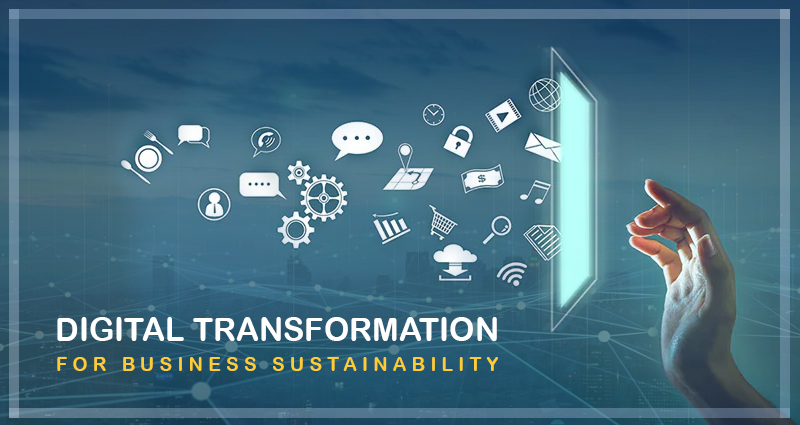
Some of the biggest issues of today’s digital age and market when it comes to business are digital transformation and business sustainability. Sustainable digital transformation means doing the right thing by performing sustainable business practices. It has to do with the stakeholder impact of not only what you build, but in what way you build it.
In order to survive as an industry leader for the long-term, it’s imperative that your business make serious efforts to transition to becoming a responsible business. To do so, we suggest you leverage tools and platforms to track and monitor the impacts of the digital solutions. It’s best to keep asking sustainability-driven questions at each crucial point in the process to ensure the end products have a positive impact.
Why Do You Need to Include Sustainability in Your Digital Transformation Journey?
Increase in industry pressure to incorporate sustainable business practices
Many businesses often undergo pressure from external shareholders to incorporate sustainable business practices. With such pressure, there’s also a demand for transparency of the practices beyond traditional press releases.
Change in consumer buying behavior
With a majority of consumers now being millennials and gen Zs, they place much focus on sustainable and ethical practices when making their buying decisions. A study conducted on 10,000 consumers on a global scale resulted in 91 percent of shoppers voting that they’ll most likely shift to brands that support an environmental or social cause. Another study also found that 90 percent of consumers would boycott brands that follow irresponsible or unethical business practices. This demographic is known to thoroughly research brands’ practices to make informed decisions on their purchases. As more organizations get involved with greenwashing, they’re looking for brands to prove their sustainability claims. Organizations can track and publish this by utilizing enterprise applications.
Increase in monitoring of supplier requirements
With the increase in awareness of sustainability, more businesses are now realizing that sustainability efforts go beyond the organization. In order to collaborate effectively on sustainable business practices with partners such as suppliers, brands must consider integrating sustainability applications into their digital transformation efforts.
Five Digital Transformation Strategies for Business Sustainability
Build Infrastructure
Many businesses across various sectors face the challenge of fragmentation, with organizations struggling with architectural issues emerging from complex combinations of enterprise and legacy systems. In order to deal with the disparity curve, a unifying digital tool is necessary to ensure efficient resource and energy distribution.
The pandemic led to rapid digitization. There’s now an increasing expectation for businesses to rethink the principles of technology used at both external and internal levels. Digital tools that can capture the value of data and come up with more sustainable solutions should be incorporated more.
Democratize Responsibility
For long-lasting sustainable transformation, the initiative needs to come from the top down and the ground up. While it’s the C-suite that creates road maps, the workforce needs to be galvanized for effective change, establishing mutual accountability and democratized stewardship.
As ecological justice enters mainstream discourse, conversations around the need to offset carbon have taken the front seat. Despite this cognitive turn, there’s still a need for governments, institutions, and businesses to back the people spearheading change to drive this movement home. Digital tools can democratize power and give all employees the opportunity to make a difference.
Focus on Measurement
Measurement is important when misinformation is so present, and there’s a huge need for people to be correctly informed. If you keep decision makers, stakeholders and the public updated with your business’s goals, achievements, and processes in a transparent manner, you’ll be better able to manage expectations and perceptions. This helps your business better understand the ecological landscape as well and drive positive impact.
Mindful Technology Usage
Using technology in today’s digital age is unavoidable but by setting boundaries on how and when it is used, you can ensure that its influence is positive. By helping people optimize behavior, make better decisions, and improve the environments they work and live in, technology can have a positive impact. With the help of data, physical as well as mental wellness can be better monitored owing to apps developed to analyze and recommend health plans.
But with all the access to data and technology, there’s a need for mindful use of technology, and how and when it gets deployed. When businesses design new interfaces and systems, empathy for customers and employees are driving factors to get buy-ins and also make businesses stand out from competitors.
By integrating sustainability strategies into your digital transformation efforts, you move beyond profit and prioritize social and environmental concerns along with business goals. In order to meet evolving customers’ expectations in today’s rapidly transforming market, businesses need to shift from short-term thinking to thinking more about business sustainability and considering the long-term impact of their decisions.
Decrease Impact
As legacy systems are now outdated, they inevitably become e-waste. This e-waste is not simply generated from hardware, the energy involved in backing up data also has its own environmental footprint. This only increases as cloud storage becomes more popular.
With real-time data, machine learning, and AI as the transformative forces of society, it’s crucial we balance sustainability benefits and technology’s environmental cost. By designing for circularity, you can decrease waste. Additionally, by making a transition to circular flows, continuous production loops, and regenerative thinking, you can reduce software and hardware obsolescence. Adopting flexible architecture that prioritizes modularity, compatibility, and connectivity can help businesses adapt to ever-evolving markets without compromising on additional resources.
Digitize Your Business Today and Be Ready for Tomorrow!
Let’s start a conversation and see how Digital Daddy can ensure your sustainable business growth by digitizing and incorporating sustainability into your digital systems.



